How To Get Grape Vines To Produce Fruit
- Home
- Yard and garden
- Find plants
- Fruit
- Growing grapes in the home garden
Quick facts
- Grapes are woody perennial vines.
- Plant in full sun to provide the heat required to ripen the fruit.
- Each vine needs about 6 feet of space.
- Flowers and fruit develop on new shoots called canes.
- It is possible to get fruit one year after planting.
- Flowers are pollinated by wind and insects.
- Vines can be trained to many decorative forms.
- Annual pruning is very important to keep growth healthy each year.
- Prune in spring before leaves emerge.
Growing grapes for many uses
Do you want to grow grapes primarily to cover an arbor? Then you can choose just about any grape variety that is hardy and reasonably healthy.
Do you hope to make grape juice and jelly? Several dependable easy-care varieties will fit this purpose. Juice and jelly grapes are traditionally some of the most winter-hardy varieties.
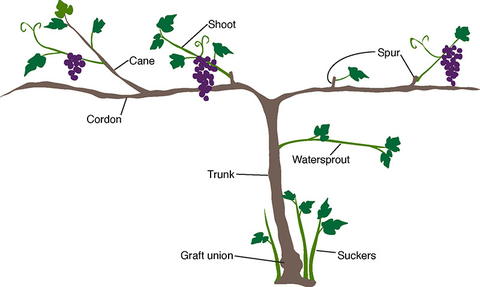
Do you want seedless grapes for fresh eating? Some seedless varieties are being grown in Minnesota now, but, except in far southern Minnesota, all of these varieties will need some winter protection. Seeded table grapes are generally more cold-hardy and vigorous than newer seedless varieties.
Grapes for wine
There are now many excellent cold-hardy wine grape varieties available for commercial and hobby winemakers in northern climates. Several of these have been developed by the University of Minnesota specifically for our harsh climate.
For winemaking you will need to choose the variety more carefully, considering what varieties will make the type of wine you want, and what training and pruning they will need. While these grapes can be eaten fresh, they generally have higher acid, higher sugar, higher skin-to-pulp ratio, and more seeds than table and juice grapes.
Follow this simple calendar to keep grapevines healthy and productive
Choosing plants
The varieties in the table below can be used for juice and jelly and some can be used for making wine. Of course any can be eaten fresh, and you might be surprised at the wide range of flavors!
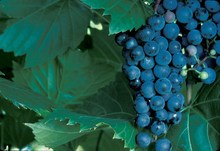
There are other varieties available at garden centers and online nurseries that are listed as being hardy to USDA zone 4, but those listed here have been carefully tested by the University of Minnesota and have proven to grow successfully in our climate.
If you're interested in more extensive information about all of these varieties, you can find a current list of nurseries at the Minnesota Grape Growers website. The University of California at Davis also maintains a national grape registry nursery list that includes northern suppliers. Please note that some nurseries only sell wholesale.
Varieties in bold were cultivated by the University of Minnesota and include the year they were introduced.
|
Grapes with seeds
Seedless grapes
Seedless grapes generally don't do well in northern climates. Three varieties that are best for fresh eating and have been tested to grow reliably in zone 4:
- Mars— Sweet, juicy, blue berries with flavor similar to Concord.
- Petite Jewel— Red berries with excellent fruity, spicy flavor (may be difficult to grow).
- Somerset Seedless— Pink-red berries that are juicy and delicious. Hardiest of the seedless varieties.
Planting, growing and maintaining grape vines
Care for your grape vines from planting and throughout the seasons, year after year.
|
In Minnesota, spring planting is recommended to give the young vines the most time to get established before their first winter.

If you order from catalogs or online sources your plants will arrive as dormant, bare root plants. When you receive the plants, keep them in a cool place with the root system moist. You should plant the vines as soon as possible.
Local nurseries also carry potted vines. These vines should also be planted as soon as possible, but because the roots are growing the timing is not as critical.
Before planting bare root vines
- Soak the roots in water for 3-4 hours.
- At planting, remove all canes except the most vigorous one.
- Plant vines with the lowest bud on the cane just above the soil surface.
- Trim off any broken or excessively long roots.
- Dig a hole large enough to you can spread the root system out.
- Then cover the roots completely with soil.
Mulching is not usually recommended for grapes because mulch will keep the soil temperature too cool. Grape vines grow best in warmer soil.
Initial watering
After planting, water the vines regularly throughout the first year. The root system needs to grow and establish to allow for shoot growth in the first year.
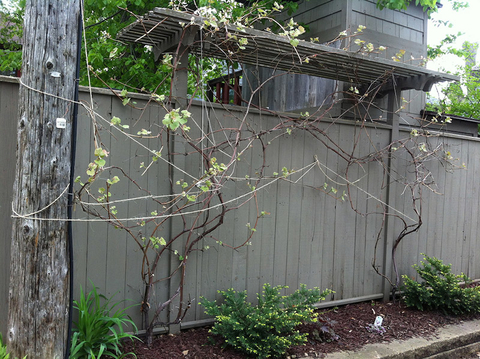
Support
Grapevines need some type of support or they will trail along the ground. The support can be an arbor covering a patio for shade, or can be as simple as a post in the ground to support the trunk of the vine.
Grapevines can also be grown along an existing fence. Virtually any type of support structure will do, provided it is sturdy. Grape vines grow quickly and get quite heavy.
Grapevines can be trained and pruned to just about any form and shape.
- Young grapes require about 1/2 to 1 inch of water per week, depending on rainfall, for the first two years during the growing season.
- When watering young vines, saturate the root zone. Apply 5 gallons of water over a 3 x 3 foot area for 1 inch of water.
- Plants grown in pots require regular watering until the roots become established and the leaves have acclimated to growing outdoors. It's worthwhile to monitor these plants daily to make sure they do not suffer drought stress.
- By the end of the second growing season, a trunk should be established and your vine is likely to not need additional watering unless specific soil conditions (sandy, well drained) or prolonged drought dictate the need.
- Apply water only to the root zone. Avoid getting grape foliage wet as this can encourage many grape diseases.
- Reduce watering young vines in the fall to encourage the plant to harden-off its canes to prepare for winter.
- Older vines seldom need any watering unless on sandy or other very well drained soils.
Fertilizer and mulch
The first two or three years, each early spring, apply compost around the base of the vines. Grape vines grow vigorously and might need a nutrient boost each year. You may not have to do this as the vines mature; it all depends on what you observe. Do the vines look vigorous and healthy? Maybe you don't need any fertilizer.
Unlike many other plants, it is best not to mulch around the base of your vine as the mulch can keep the soil too cool. Grapevine roots like to be warm.
Weeding
Keep grass and other plants from growing under grapevines. This allows the soil to heat up early in the spring and maintain higher soil temperatures to encourage growth.
When plants grow under vines, the soil temperature stays cooler. With grapes, this will delay growth in the spring.
Keep the ground under the vines clear of other plants throughout the growing season by hoeing gently under the vines.
Watch before pruning your grapes this winter:
- Pruning grapevines in Minnesota
- UMN Extension Grapevine winter injury
- Pruning out grapevine trunk diseases
- Pruning New Vines – One or Two Years Old
- Pruning high cordon grapevines in Minnesota (intermediate to advanced)
Grapevines must be pruned every winter or spring. It is an important step to growing grapes, because it helps them produce a healthy crop of fruit and survive for many years.
New grape growers are often surprised about how much of the vine gets removed during pruning. In an average vineyard, 80-90% of the new growth is pruned off each winter. This is because grapes are produced on new shoots, not old branches.
The exact process of pruning grapes depends on how you decide to grow them in your garden and how much space you have. But generally, grapevines are pruned to 1-2 trunks, 2-4 cordons (woody arms), and bud-containing spurs that produce the next season's fruit.
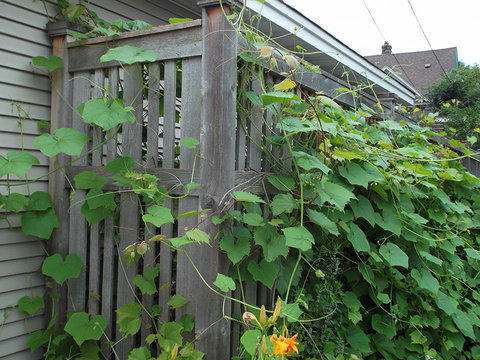
Fences are ideal to use as support for vines. Vines can also be contained to one stake in the ground. If you have an arbor or pergola, grapevines can be grown over the top to produce shade. If your goal is shade, you may prune less than if your goal is fruit. If your goal is to produce a lot of high quality fruit, it is best to grow it on a basic trellis or fence where it will have lots of sunlight.
Remember, flowers and fruit are located on buds that developed the previous year. Therefore you need to encourage new growth, but not too much.
Year one
For the first year, pruning is the same no matter how you plan to train your vine. The key is to develop a strong root system and straight trunk.
- After the first season, your dormant vine will probably have one or several main canes, with skinny lateral canes growing off of them.
- Choose the healthiest 1-2 main canes, and remove the rest. Prune off all of the lateral canes that are branching off of the main one.
- Tie this cane to a stake or to the fence and encourage it to grow straight up.
- Remove the top of the main cane to force the vine to grow lateral shoots the next season. The amount you remove depends on how healthy the cane is. Prune back to where the cane is pencil-diameter and the buds look plump and healthy.

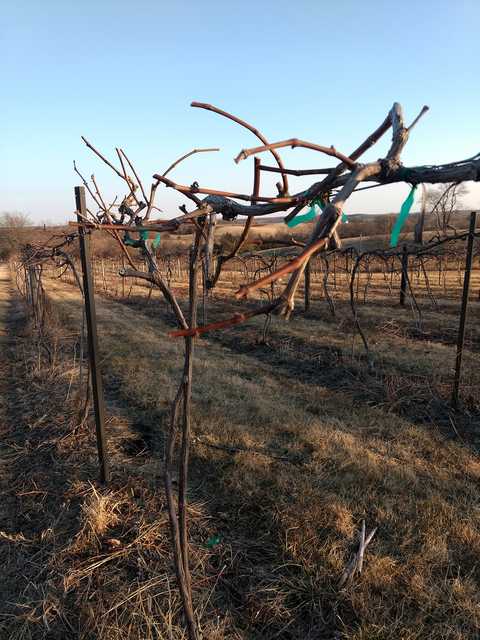
After year one
During the second summer, train lateral shoots onto the trellis or fence, so that they run parallel to the ground, on both sides of the trunk.
Once the trunk has reached the trellis and is the height that you want it, and the lateral cordons (arms) have been formed, prune the vine each winter or spring before growth begins.
- Remember, fruit is produced on the current season's growth, which grows off of last season's wood.
- Heavy pruning provides the best fruit.
- Light pruning results in large yields of poor-quality fruit.
- Table, juice, and jelly varieties can have 40 to 60 buds per vine after pruning, but wine varieties should have only 20 to 30 buds per vine after pruning.
Pruning old, neglected vines
Have you moved into a house and inherited some old, overgrown grapevines? Don't dig them out just yet; they can probably be saved!
You want to prune old and neglected vines in stages. Your goal is to get the vine back to a single trunk with well-placed canes. Prune when the vine is dormant, just before growth begins in spring.
If the vine is overwhelmingly large or has excessive dead wood, it is fine to cut off the entire vine a few inches above the ground. This will encourage new canes to grow from the ground (suckers) that you can use to re-grow the grapevine from scratch. This is a common practice.
Even if you wish to leave behind some of the old growth, you should still start a new trunk, and remove the old one once the new one is established:
- Select a new trunk from canes growing from the base of the vine.
- Cut the chosen new trunk to back to the desired height.
- Choose two canes on each side to bear fruit this season and tie them to a trellis as they grow. If there are no lateral canes, wait until the next season and choose two new shoots to become the cordons, removing others lower down.
- Remove other old wood. You might be cutting out a LOT of old wood.
- Continue pruning and training as with a new vine.
The best way to tell if grapes are ripe is to taste a few. Many varieties turn color before they are ripe.
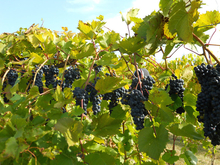
To harvest
- Clip full clusters off the vine with pruning shears or heavy scissors.
- Handle clusters carefully.
- Remove any discolored, injured, or undesirable berries.
- Cool them as soon as they are picked.
To store
- Store grapes in a refrigerator in a steady, consistent temperature.
- Cover grape clusters loosely with plastic to reduce moisture loss.
- Most grapes can be stored in the refrigerator for up to a week or two.
In particularly harsh years, winter injury may sometimes kill much of the vine.
Grapevines are often able to regrow new canes from low down on the trunk. You may need to limit pruning for the year to determine how much of your vine has died.
It might be easier to start again with a cane from the base of the vine and treat the vine like you just planted it. Because the vine will have a large root system, you might be surprised at how fast it will regrow.
Managing diseases, insects and other pests
Most insect and other problems can be reduced by planting vines in a sunny location with good air circulation.
Weather conditions, winter hardiness of the variety, infection from the previous year, history of pesticide use and surrounding vegetation can affect a vine's susceptibility for a particular year.
|
Japanese beetles
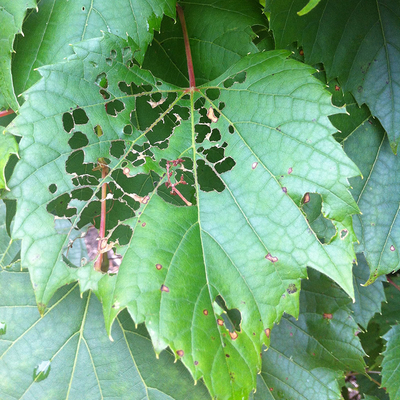
Japanese beetles chew holes in the leaves leaving them with a lace-like appearance. Look for beetles and their damage beginning in late June or early July through August.
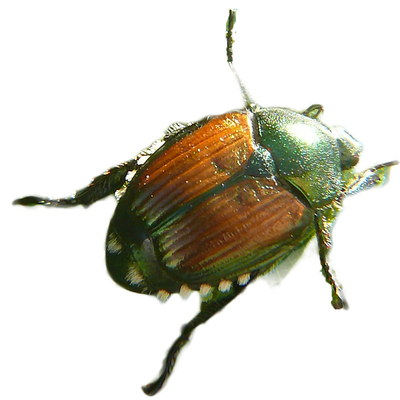
Having Japanese beetles on a plant attracts more beetles, so it's important to prevent accumulation. The best control for home gardens is to check your plants often, at least twice a week and ideally in the morning when they're less active, and knock beetles into a pail of soapy water.
Monitor frequently and throughout the growing season for any other potential pest outbreaks. As with diseases, cleaning up dead leaves and berries and cleaning under the vines will help.
Spotted wing drosophila
This invasive fruit fly prefers strawberries and raspberries, but also feeds on grapes. This pest can do significant damage in large numbers and should be reported to the Minnesota Department of Agriculture when found.
Other insects
Yellow jackets and multicolored Asian lady beetles may feed on ripening grapes, damaging the fruit and promoting fungal disease infection. The best prevention is harvesting grapes as soon as they are ripe.
Other creatures
Birds are attracted to the ripening berries and can eat them all before you are ready to harvest. The only foolproof method of protection is netting to cover the ripening fruit on the vine.
Deer and raccoons may need to be kept out with a fence if they prove to be a problem.
Good air circulation in very important for preventing most diseases. This means annual pruning to keep the canopy from getting too dense.
Equally important is raking and removing leaves each fall as well as picking up and composting fallen fruit. After pruning, remove cuttings away from the vines. These practices will remove some of the places disease can overwinter to infect the following spring.
If possible, diseased portions of a vine should be removed and discarded at the first sign of disease, to prevent spread to the rest of the vine.
Powdery mildew
This fungal disease can infect all parts of the grapevine.
- The first sign of infection appears as a white powdery layer on leaves or fruit.
- Leaves infected while they are still growing become distorted and stunted.
- If grapes are infected when they are small, the skin stops growing but the pulp continues to expand and the berry splits.
- If infection occurs during fruit ripening, purple or red varieties fail to color properly and look blotchy at harvest.
Downy mildew
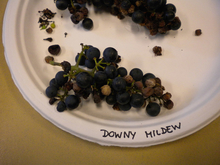
This fungus can infect any actively growing parts of the vine.
- When lesions form on leaves, the affected areas become brown and wither.
- Severely infected leaves curl and drop from the vine.
- When parts of the vine are infected, they frequently become distorted, thickened, or curled with a white downy appearance.
- If the infection is severe enough, parts of the vine will wither and die.
- If grapes are infected, they fall off the vine.
High humidity promotes infection from both powdery and downy mildews. Infected shoots should be pruned and destroyed. Pruning in late winter should increase air circulation, as the vine grows during the year with the goal of reducing the chance of heavy infection.
Make sure all leaves and rotted fruit are removed from around the vine to reduce infection.
Fruit rots
Common fruit rots of grapes in Minnesota include Botrytis bunch rot, black rot, phomopsis, anthracnose, and sour rot. These fungal diseases can cause complete crop loss in warm, humid climates.
Botrytis infection can be seen on leaves, petioles, shoots and grapes. Prune grapevines during dormancy and position shoots during the growing season to allow exposure of fruit to sunlight and good air flow through the canopy. Pruning and training are also helpful in controlling Botrytis bunch rot.
Botrytis fruit rot can grow on dead blossom parts in the cluster.
- Before grapes begin to ripen, it moves from berry to berry within the bunch.
- Botrytis occurs most commonly on ripening berries, where infection and rot spread rapidly throughout the clusters.
For black rot, grapes are susceptible from bloom until about 6 weeks later. Symptoms seen after that time period are due to an infection that occurred earlier.
- Infected berries first appear light brown.
- Black spore-producing bodies develop on its surface.
- Later, the berries shrivel and turn hard and black to become mummified.
Herbicide damage
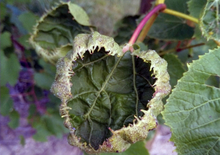
Grapes are very susceptible to damage from 2,4-D and dicamba herbicides, which are widely used to control dandelions, creeping charlie and other weeds in lawns. Many common, store-bought weed killer products contain 2,4-D and dicamba, so gardeners may be applying them without realizing it.
- 2,4-D and dicamba are very susceptible to vaporization and drift through the air after they are sprayed. This means that they can drift long distances and from neighboring yards.
- Exposure to herbicide causes deformed leaves and causes flower clusters to fall off. Avoid using these herbicides anywhere near grapevines.
- If you hire a lawn care company, consider asking them not to spray for dandelions or creeping charlie, as 2,4-D and dicamba are frequently used to control those weeds.
You might want to ask your neighbors to not use them either.
Poor fruit set
Small or sparse clusters are usually a result of poor pollination of the grape flower clusters during bloom. Poor fruit set is sometimes called "hens and chicks" because some berries on the clusters are much smaller than others and ripen unevenly.
While grapevines are self-pollinating, pollination can still occur for several reasons:
- Cool weather or very hot weather before or during bloom.
- Fungicides applied before or during bloom.
- Boron or zinc deficiency.
- Too much or too little nitrogen.
Emily S. Tepe; Emily E. Hoover, Extension horticulturalist; Matthew Clark, Extension grape breeding specialist and Annie Klodd, Extension educator
Reviewed in 2021
How To Get Grape Vines To Produce Fruit
Source: https://extension.umn.edu/fruit/growing-grapes-home-garden
Posted by: grantforgent.blogspot.com

0 Response to "How To Get Grape Vines To Produce Fruit"
Post a Comment